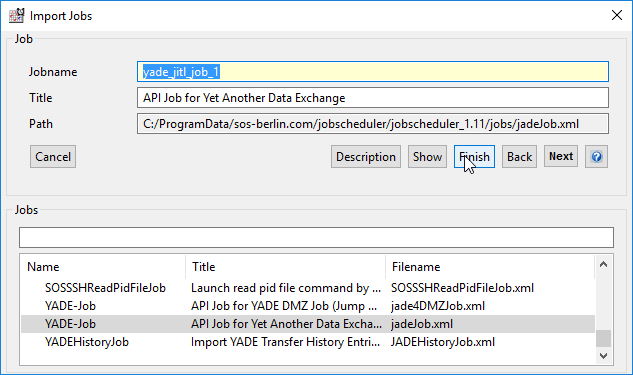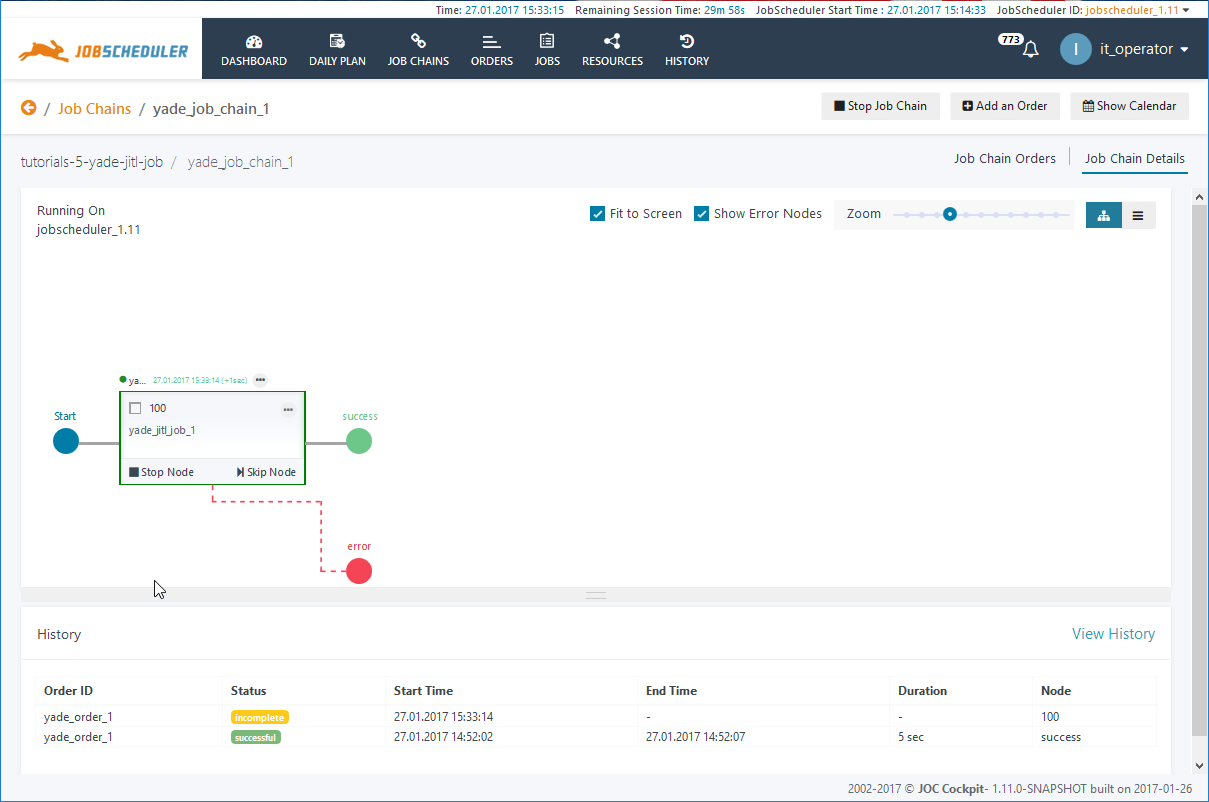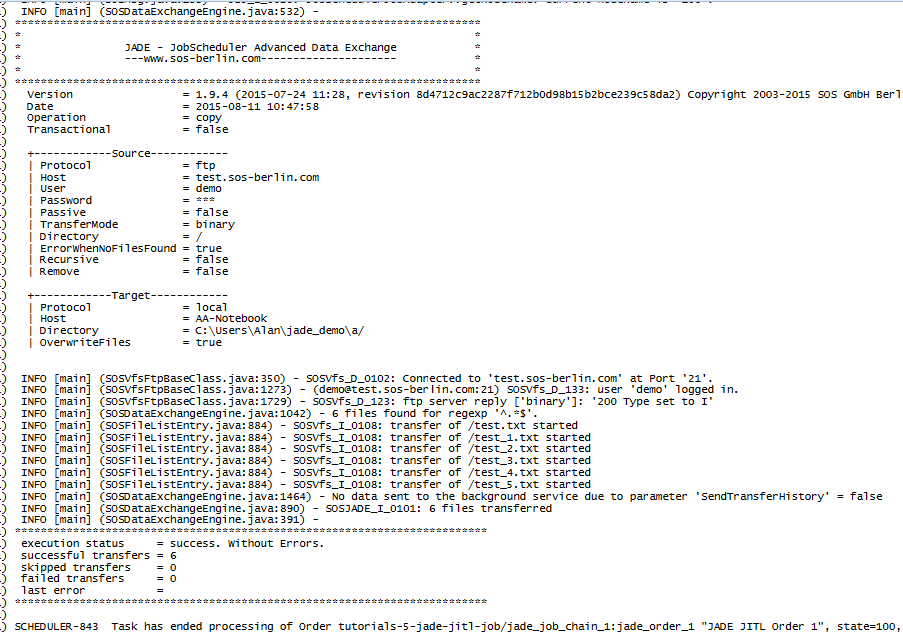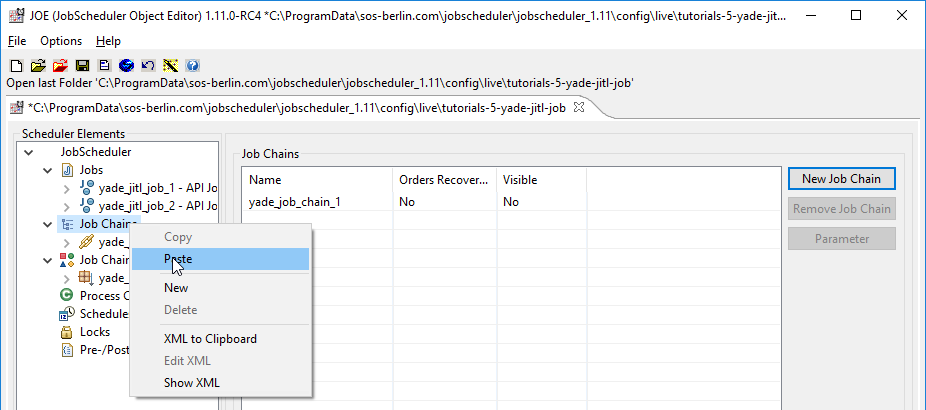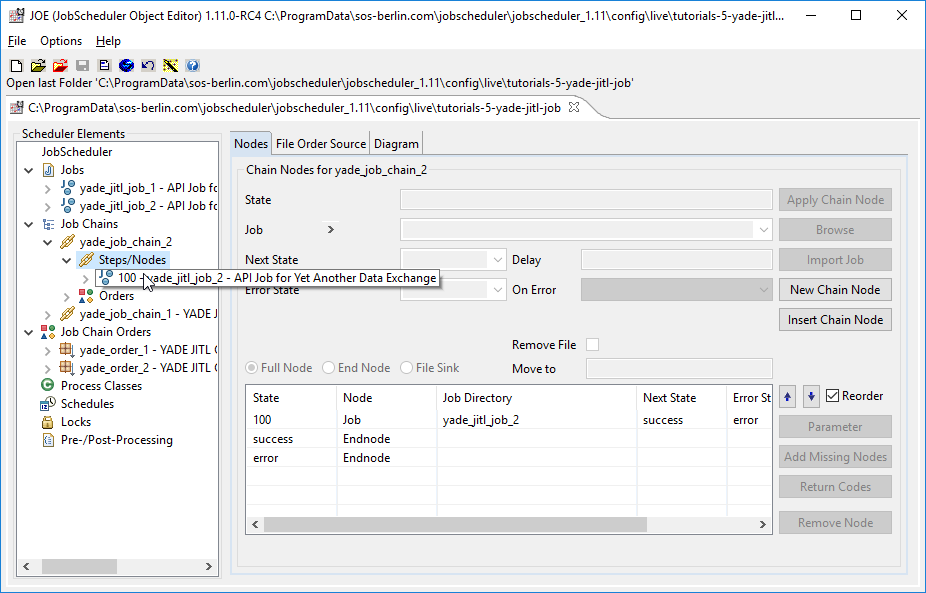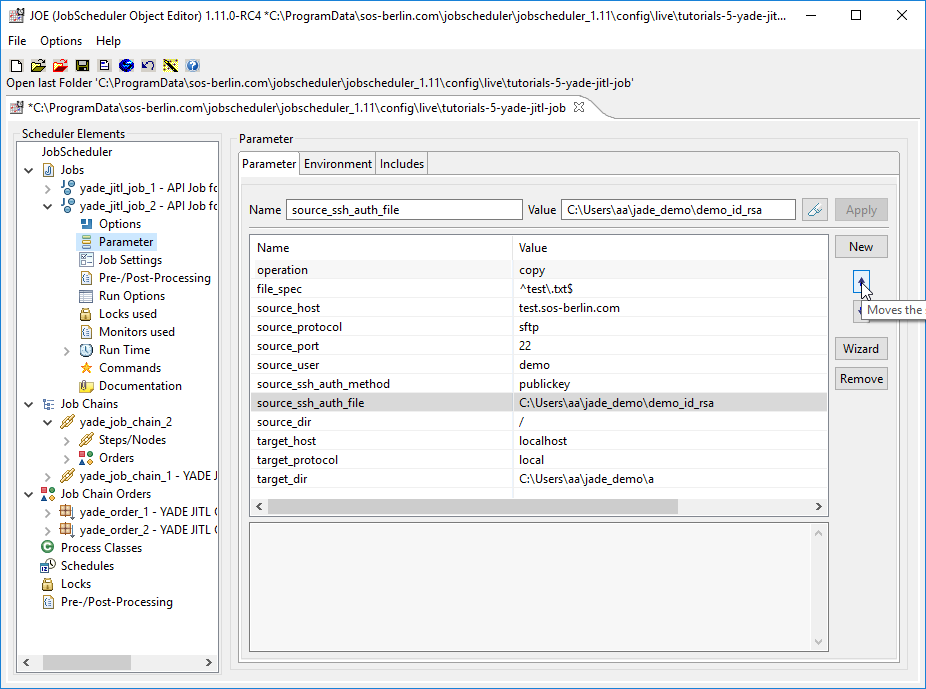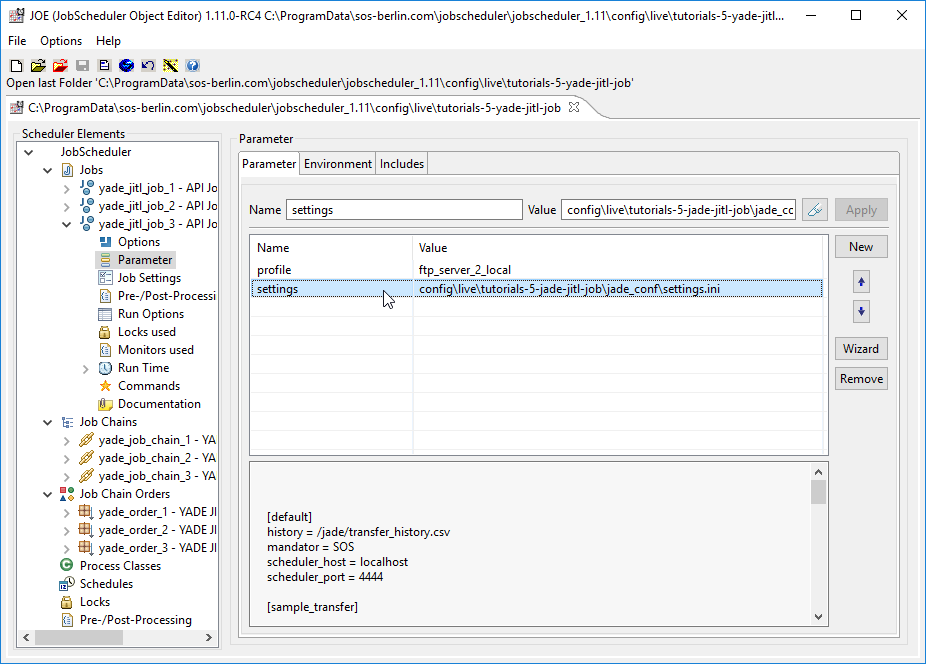| Table of Contents |
|---|
Introduction
JobScheduler has a full JADE YADE managed file transfer program "on board". This allows JobScheduler features such as file polling watching and run time periods to be readily combined with JADEYADE's managed file transfer features such as error detection, compliant logging and notifications.
JADE YADE can be accessed from the JobScheduler using one of the JADE YADE JITL jobs, via the JADE YADE API. The JITL jobs are pre-configured job templates that can be used to rapidly develop job scheduling operations and are provided as standard with every JobScheduler installation package.
The configuration and use of a simple JITL job was is described in JobScheduler - Tutorial 4 - Configuring and Running a JITL Job: the current tutorial will build builds on the information provided in the Editing and Running a JITL Job tutorial and show that tutorial and shows how to configure , and run and test simple file transfer operations with the JADEJobwith the YADE Job. The current tutorial starts with the configuration of a simple file transfer operation and proceeds to showing how to include public/private key authentication and job configuration with external files. Users should then be able to build on use this information to complete configure their own real-life transfer operations.
...
List of Tutorials
The screenshots used in this tutorial were made using JobScheduler 1.9.This tutorial assumes that a JobScheduler has been installed and is running. See the other tutorials in this series are:
- JobScheduler - Tutorials - Introduction and Requirements
- JobScheduler - Tutorial 1 - Running a simple job using the JOC Cockpit
- JobScheduler - Tutorial 2 - Editing a Simple Job with JOE
- JobScheduler - Tutorial 3 - Running an Order Using the Run Time Parameter
- JobScheduler - Tutorial 4 - Configuring and Running a JITL Job
- JobScheduler - Tutorial 5 - The YADE JITL Job - Configuring and running file transfer jobs (this tutorial)
- JobScheduler - Tutorial 6 - Configuring and Running Standalone Jobs
Background
The screenshots used in this tutorial were made using JobScheduler 1.11.
This tutorial assumes that a JobScheduler has been installed and is running. See the JobScheduler - Tutorials - Introduction and Requirements for an introduction to the requirements for the installation of JobScheduler and links to instructions about the installation procedure itself.
This tutorial describes how to configure the YADE JITL Job to carry out a simple file transfer operation - transferring all the files found in a folder on a remote server to the local file system. This operation described has already been used in the The YADE Client Command Line Interface - Tutorial 1 - Getting Started, and involves the transfer of files from the online SOS test server to the user's local file system. The test for an introduction to the requirements for the installation of JobScheduler and links instructions about the installation procedure itself.This tutorial describes how to configure the JITL JADEJob to carry out a simple file transfer operation - transferring all the files found in a folder on a remote server to the local file system. This operation described has already been used in the JADE file transfer tutorial, and involves the transfer of files from the online SOS demo server to the local file system. The demo server server allows read-only FTP and SFTP access and has been installed to allow help users to get their jobs up, running and running tested as quickly as possible.
Note that to get the file transfer operation described in this tutorial up and running, your firewall(s) will need to allow file transfer via ports 21 (for FTP) and 22 (for SFTP).
A separate installation of JADE YADE is not required for this tutorial.
Parameter Settings in JADE
For ease of reference, the parameters specified in the JADE tutorial were:
[ftp_server_2_local] operation = copy source_protocol = ftp source_port = 21 source_user = demo source_password = demo source_dir = / target_host = localhost target_protocol = local target_dir = ${USERPROFILE}\jade_demo\a |
Configuration of a simple JITL JADEJob (FTP protocol, password authentication)
The first three steps have already been described in detail in the JobScheduler - Tutorial 2 - Editing a Simple Job with JOE tutorial and are therefore only summarized here:
...
- A sub-folder "tutorials-5-jade-jitl-job" of the live folder is used in this tutorial for all the objects.
A copy of this sub-folder can be downloaded from ????
...
Click on the Finish button to create the new job and close the wizard.
| Info | ||
|---|---|---|
| ||
Note that use of the wizard to configure the job parameters as described in Tutorial 4 - Configuring and Running a JITL Job - i.e. proceeding by clicking on Next instead of Finish - is not recommended for this job. |
, the YADE JITL Job uses the JobScheduler's own YADE.
Example File Download
This tutorial describes the individual steps required to configure the Job, Job Chain and Order objects used in the examples. In addition, a completed configuration can be downloaded by users that just want to see how the examples work:
The download archive contains three sets of JobScheduler elements, each made up of a Job, a Job Chain and an Order. Each set of elements has a common suffix: _1, _2 or _3 and provides a working configuration for each of the three examples described in this tutorial:
- A simple JITL YADE Job (FTP protocol, password authentication),
- File transfer using the SFTP protocol and public/private key authentication,
- Configuration using a Profile and
settings.inifile.
The download archive can be unpacked and the contents copied to your JobScheduler live folder where they can be run with one minor change:
- In the
settings.inifile (found in thetutorials-5-yade-jitl-job/yade_confsubfolder):- Change the username in the target_dir parameter from myUserName to an appropriate value for the user's system
(Linux users will need to make wider changes to this parameter according to the requirements of their system.
- Change the username in the target_dir parameter from myUserName to an appropriate value for the user's system
Example 1 - Configuring and Running the YADE JITL Job (FTP transfer, password authentication)
Configuring the JITL Job in JOE
The first three steps have already been described in detail in the JobScheduler - Tutorial 2 - Editing a Simple Job with JOE tutorial and are therefore only summarized here:
- Start JobScheduler
- Open the JobScheduler Object Editor (JOE)
- In JOE, open the Open HotFolder function and use the Make New Folder to generate a sub-folder in the JobScheduler's Live folder. In this tutorial this sub-folder is given the name
tutorials-5-yade-jitl-job. Now click OK to open this folder. - In the left hand pane of JOE select the Jobs icon - opening the JobScheduler icon if necessary. Now use the wizard function to import the YADE JITL Job by clicking on the Wizard button as shown in the screenshot below.
- In the small window that will now open, select Order controlled job and then Next, which will open the Import Jobs window as shown in the next screenshot.
- Enter a Jobname such as yade_jitl_job_1, as shown in the screenshot.
- In the Jobs pane, scroll down until the two YADE Jobs are visible and select the second YADE-Job (the one without DMZ in its file name).
This will cause the Title field to be filled with "API Job for JobScheduler ...." as shown in the next screenshot: Now click on the Finish button to create the new job and close the wizard.
Info title Deprecated Parameters Note that use of the wizard to configure the job parameters as described in Tutorial 4 - Configuring and Running a JITL Job - i.e. proceeding by clicking on Next instead of Finish - is not recommended for this Job and an alternative method will be described.
This is because in releases up to and including 1.9 the wizard uses parameters which have now been deprecated and which would considerably restrict the configurations possible for the JITL Job.
For more information see
.Jira server SOS JIRA columns key,summary,type,created,updated,due,assignee,reporter,priority,status,resolution serverId 6dc67751-9d67-34cd-985b-194a8cdc9602 key JITL-201 - You will now be returned to JOE's Jobs tab where the yade_jitl_job_1 will be listed.
- In the small window that will now open, select Order controlled job and then Next, which will open the Import Jobs window as shown in the next screenshot.
- Open the yade_jitl_job_1 in JOE's left hand pane and select the Parameter element as shown in the next screenshot.
- Now enter the parameter name/value pairs required to configure this Job.
- There are a number of approaches that can be taken to specifying the parameter name/value pairs in for this Job:
- Use the job Parameter form shown above to enter the parameter pairs and store the information in theJob configuration. This is the simplest approach and will be described first in this tutorial.
- Specify a
settings.inifile and Profile in job Parameter form and then enter the necessary parameters in this file using a text editor. This procedure is described in the Use of a Profile and settings.ini file section of this tutorial. - Note that it is also possible to create a custom JITL job by duplicating the YADE JITL job in the JobScheduler data jobs folder and directly editing this file. This procedure is outside the scope of this tutorial.
The values of the necessary parameter name/value pairs can be taken from the list below, which users that are familiar with the YADE tutorials will recognize as being the parameters for the first YADE tutorial:
Code Block language text title YADE Parameter Settings operation = copy source_host = test.sos-berlin.com source_protocol = ftp source_port = 21 source_user = demo source_password = demo source_dir = / target_host = localhost target_protocol = local target_dir = ${USERPROFILE}\yade_demo\aNote that the
${USERPROFILE}value must be replaced with a suitable path to the desired target directory.- The use of the job Parameter form is very similar to the use of the JITL job parameter wizard already mentioned. The use of the wizard was described in detail in the Configuring and Running a JITL Job tutorial and the use of the Parameter form should therefore not require any further explanation.
- There are a number of approaches that can be taken to specifying the parameter name/value pairs in for this Job:
- The Job Parameter form will appear as shown below once all the parameter pairs have been entered:
- Note that the value of the target_dir parameter shown in the screenshot has been changed from the parametrized value used in YADE (i.e.
${USERPROFILE}\yade_demo\a) to an absolute value.
This is because the JobScheduler on the system used to configure this tutorial runs under its own user account and therefore the${USERPROFILE}variable would return the wrong path.- Information about finding exact YADE parameter definitions is given in the YADE parameter definitions section in this tutorial.
- Note that the value of the target_dir parameter shown in the screenshot has been changed from the parametrized value used in YADE (i.e.
- Create a new Job Chain for the yade_jitl_job_1 job:
- Add the Job to the Job Chain along with two end nodes as shown:
- Create and configure an Order for the Job Chain:
- Don't forget to save the configuration as shown above.
- Add the Job to the Job Chain along with two end nodes as shown:
Run the Order in the JOC Cockpit
The procedure for running this Order is the same as already described in other tutorials in this series:
Log into the JOC Cockpit and select the Job Chains view.
In the left-hand tree menu select thetutorials-5-yade-jitl-jobfolder and in the yade_job_chain_1 card select Show Job Chain Details.Open the Order menu and select Start Order now.
Processing of the Order will be shown in near real-time. Once processing has started the Job Chain card will be highlighted as shown in the next screenshot as well as in the Job Chain History list below:- After the Order has completed the status should show successful. Clicking on any entry in the History list will open the Order log file.
The screenshot below shows an extract from the log file for this Order and the detailed log information that is available for YADE file transfer operations:
As can be seen from the log file, six files have been copied to the...\yade_demo\afolder. These were all the files in the remote folder as a filter was not specified to select particular files.
Troubleshooting
If an Order ends in error the Error Text can be conveniently read in the History view by clicking on the dark grey triangle to the left of the Order ID as shown in the next screenshot:
Firewall Problems
Firewalls can cause problems and may block FTP file transfer if the necessary ports are not open.
In addition some firewalls require that FTP passive mode is used. An error message such as:
- "
Processing terminated, 'getFilenames' causes an exception error"
is likely to be avoided if JOE is used to add a passive_mode parameter with value true to the parameters that were set for the yade_jitl_job_1 job as described above.
The default setting for the passive_mode parameter is false.
Example 2 - File Transfer using the SFTP protocol and public/private key authentication
YADE and therefore the YADE JITL Job can be configured to use a range of protocols, including SFTP, and to use public/private key authentication. The configuration of the YADE JITL Job using SFTP and public/private key authentication is the subject of this section.
As with the simple file transfer using FTP protocol and password authentication described above, this job downloads files from the SOS demo server and saves them on the local file system. The configuration of the YADE Command Line Client to carry out this operation was described in The YADE Client Command Line Interface - Tutorial 6 - Public / Private Key Authentication tutorial and we recommend that you follow the instructions contained in that tutorial to download and install the necessary rsa private key file.
Job Configuration
- Public/private key installation:
- Follow the instructions in the YADE Tutorial 6 - Public / Private Key Authentication article (linked above) to download and correctly save the demo_id_rsa private key.
- Create a new Job, Job Chain and Order for this example:
- Either:
- Use the context menu for elements in JOE's left hand Scheduler Elements pane to copy and then paste the individual objects as shown in the next screenshot:
- or duplicate the objects at the file level and then load them into JOE using the 'Reload Configuration' icon (the arrow symbol with a grey background).
- Use the context menu for elements in JOE's left hand Scheduler Elements pane to copy and then paste the individual objects as shown in the next screenshot:
- The new Job Chain and Order objects now need to be modified so that the new Job Chain specifies the new Job and the new Order specifies the new Job Chain.
See the JobScheduler - Tutorial 2 - Editing a Simple Job with JOE for instructions. - After the objects have been duplicated and modified the Scheduler Elements pane in JOE should appear similar the next screenshot:
- This initial configuration can now be tested by running the new Order in the JOC Cockpit using the Start Order Now function as described for Example 1 above.
- Either:
- The parameters in the
yade_jitl_job_2now need to be changed from FTP to SFTP and the authentication method from password to public key:- The parameters required for these changes are shown in the next screenshot:
- The file_spec parameter has been added to introduce the YADE regex filter - instead of the seven files found and downloaded from the test server in Example 1 only one matching file will be found and downloaded - the
test.txtfile. - Once again, the use of the wizard is not recommended for modifying the parameters - instead they should be set using the editing functions provided directly in JOE's Parameters tab.
- The file_spec parameter has been added to introduce the YADE regex filter - instead of the seven files found and downloaded from the test server in Example 1 only one matching file will be found and downloaded - the
- Save the changes.
- The parameters required for these changes are shown in the next screenshot:
- Now run the Order using the JOC Cockpit in the same way that the Order for the yade_jitl_job_1 was run in Example 1 above.
As already mentioned, the Order should cause one file to be downloaded from the test server to the local_dir folder - this file can be seen in the Order log file as shown in the next screenshot:
Example 3 - Job Configuration using a Profile and settings.ini file
The YADE JITL Job can also be configured to use file transfer configurations saved in a file that is independent of the JITL job. This has the advantage that one instance of the configuration can be tested and reused in a number of JITL jobs.
Note that up to and including release 1.10 of YADE and JobScheduler both the YADE JITL job and the Command Line Client save configurations in the form of one or more Profiles in a text-based settings.ini file. From release 1.11 onwards this approach will be replaced with an XSD schema-based XML file. See the YADE User Manual - Using the YADE Client article for more information about this change.
Profiles can be called from other Profiles, which means that a system of reusable configuration fragments can be built up. This is described in the Example of a global profile with fragments article.
The profile and settings file are specified with parameters of the same names in the JITL job Parameter form, as shown in the screenshot below:
The screenshot also shows that a new Order, Job Chain and Job have been configured for this example.
The full settings.ini file as included with the example download is listed in the following code block:
| Code Block | ||||
|---|---|---|---|---|
| ||||
[ftp_server_2_local]
;;
operation = copy
;;
source_host = test.sos-berlin.com
source_protocol = ftp
source_port = 21
source_user = demo
source_password = demo
source_dir = /
;;
target_host = localhost
target_protocol = local
target_dir = C:\Users\myUserName\jade_demo\a
;;passive_mode = true
[sftp_server_2_local]
;;
operation = copy
file_spec = ^test\.txt$
;;
source_host = test.sos-berlin.com
source_protocol = sftp
source_port = 22
source_user = demo
source_ssh_auth_method = publickey
source_ssh_auth_file = C:\Users\myUserName\jade_demo\demo_id_rsa
source_dir = /
;;
target_host = localhost
target_protocol = local
target_dir = C:\Users\myUserName\jade_demo\a |
- Note that in the above listing:
- profile names are written between square brackets - e.g.
[sftp_server_2_local], - the double semi-colons ( ";;" ) mark the start of comment lines.
- profile names are written between square brackets - e.g.
The code list above shows that the settings.ini file contains profiles for both the FTP transfer operation described in the Example 1 and for the SFTP operation described in Example 2. Changing the value of the profile parameter in yade_jitl_job_3 will change the transfer operation carried out by the job.
...
- There are a number of approaches that can be taken to specifying the parameter name/value pairs:
- Use job Parameter form to enter parameter pairs and store the information in the job configuration. This is the simplest approach and will be used in this tutorial.
- Specify a
settings.inifile and Profile in JOE's job Parameter form and then enter the necessary parameters in this file using a text editor. This procedure will be described later in this tutorial.Status colour Yellow title ToDo - Create a custom JITL job by duplicating the JADE JITL jjob in the JobScheduler data jobs folder and directly editing this file. This procedure will also be described later.
Status colour Yellow title ToDo
- The values of the necessary parameter name/value pairs can be taken from the list in the Parameter Settings in JADE subsection above.
...
- Note that the value of the target_dir parameter shown in the screenshot has been changed from the parametrized value used in JADE (
${USERPROFILE}\jade_demo\a) to an absolute value.
This is because the JobScheduler on the system used to develop this tutorial does not run under the normal Windows user account and therefore the ${USERPROFILE} variable would return the wrong path. - Information about finding exact JADE parameter definitions is given in the JobScheduler - Tutorial 5 - the JADE JITL Job I - Configuring and running a simple file transfer job section in this tutorial.
...
Configuration Download
- An archive containing the the job, job chain and order objects used in this tutorial is available for download:
- This file can be unpacked and the contents copied to your JobScheduler live folder where they can be run with one minor change:
- The archive contains three sets of JobScheduler elements, each made up of a job, a job chain and an order. The elements relevant to the above example all have the suffix _1 in their names.
Note that the value for the author's username in the local_dir parameter in the download file has to been changed from the value shown in the screenshots (Alan) to myUserName. You will need to change this value to the appropriate value for your own system.
- The archive contains three sets of JobScheduler elements, each made up of a job, a job chain and an order. The elements relevant to the above example all have the suffix _1 in their names.
File Transfer using the SFTP protocol and public/private key authentication
JADE and therefore the JITL JADEJob can be configured to use a range of protocols, the most important of which is probably SFTP, and to use public/private key authentication. The configuration of a JITL JADEJob using SFTP and public/private key authentication is the subject of this section.
As with the simple file transfer using FTP protocol and password authentication described above, this job downloads files from the SOS demo server and saves them on the local file system. The configuration of the JADE Command Line Client to carry out this operation was described in The JADE Client Command Line Interface - Tutorial 6 - Public / Private Key Authentication tutorial and we recommend that you follow the instructions contained in that tutorial to download and install the necessary rsa private key file.
Job Configuration
...
- Follow the instructions in the JADE Tutorial 6 - Public / Private Key Authentication article linked above to download and correctly save the demo_id_rsa private key.
...
- In the test environment used to make the screenshots for this tutorial the job, job chain and order created for the previous tutorial were first simply copied on the file system and their names changed from *_1 to *_2.
- If returning the focus to JOE does not bring a message that files have been modified and and the question if the configuration should be reloaded, then force a reload using the grey Reload button with the arrow at the top left of JOE.
- Update the job in the job chain object and the job chain in the order object to the correct values, if necessary following the screenshots in the Simple File Transfer example above as a guide.
...
- Do not forget the change the value of the author's username (Alan) in the local_dir parameter to a suitable value for your system.
...
- The value set for the local_dir parameter is an absolute value, whereas a global variable -
${USERPROFILE}- was used in the JADE Client tutorial linked above.
This is because the JITL Job is executed under the JobScheduler user whereas the JADE example is executed under the current user account ID.
...
The file transfer log (accessed in JOC as described in the Simple File Transfer example) should show that one file was copied to the local_dir folder.
Note that the file_spec parameter set in this example introduces file name filtering and reduces the number of files found - six were found in the Simple File Transfer example - to one.
Configuration Download
- An archive containing the the job, job chain and order objects used in this tutorial is available for download:
- This file can be unpacked and the contents copied to your JobScheduler live folder.
Note that the value for the author's username in the local_dir parameter in the download file has to been changed from Alan to myUserName.
Use of a Profile and settings.ini file
The JADE JITL Job can also be configured to use file transfer configurations saved in a file independent of the JITL job. This has the advantage that the configuration - or parts of the configuration - can be tested and reused in a number of JITL jobs.
Note that up to and including release 1.10 of JADE and JobScheduler both the JADE JITL job and the Command Line Client save configurations in the form of one or more Profiles in a text-based settings.ini file. From release 1.11 onwards this approach will be replaced with an XSD schema-based XML file. See the JADE User Manual - Using the JADE Client article for more information about this change.
Profiles can be called from other Profiles, which means that a system of reusable configuration fragments can be built up. This is described in the Example of a global profile with fragments article.
...
| Info | ||
|---|---|---|
| ||
We recommend that only the settings and profile parameters are set in the JITL job parameter form and that all other configuration parameters are set in the Profiles. While this may appear contradictory to our design policy for other SOS products, where merging configuration sources is possible, inconsistencies in the implementation of JITL job parameters when used together with a settings.ini file make this approach recommendable. See the JADE JITL Job Wizard behavior inconsistent when used with settings.ini file issue for more information. |
Note also:
Profiles. For more information see
|
Note also:
- The path to the settings.ini file is relative to the ${SCHEDULER_DATA} folder, which on a Windows computer with a default JobScheduler installation would be:
C:\ProgramData\sos-berlin.com\jobscheduler\JobScheduler_ID
where JobScheduler_ID is the ID given to the JobScheduler during installation
- We suggest that the settings.ini file is included in a folder within the JobScheduler live folder to simplify portability. For example:
- settings =
config\live\js-tutorials-yade-jitl-job\yade_conf\settings.ini
- settings =
- Parameter variables such as The path to the settings.ini file is relative to the
- ${SCHEDULER_DATA} folder
- , which on a Windows 7/8 computer with a default JobScheduler installation would be:
C:\ProgramData\sos-berlin.com\jobscheduler\JobScheduler_ID\
where JobScheduler_ID is the ID given to the JobScheduler during installation- can be used when configuring a file transfer in the JITL Job Parameter form, are not interpreted from a settings file.
- This means that the target_dir parameter which in the listing in the Parameter Settings in YADE subsection above has the value:
${USERPROFILE}\yade_demo\a
is changed to:
- This means that the target_dir parameter which in the listing in the Parameter Settings in YADE subsection above has the value:
- Parameter variables such as
${SCHEDULERbase_DATApath}, which can be defined and used when configuring a file transfer in the JITL Job Parameter form, are not interpreted from a settings file.- This means that the target_dir parameter which in the listing in the Parameter Settings in JADE subsection above has the value:
${USERPROFILE}\jade_demo\a
is changed to:
Parameter variables such as ${base_path} can be defined and used within a Profile. However they are not available in other profiles. See the JADE-47 - Make parameter-substitution in profiles possible issue for more information.Jira server SOS JIRA columns key,summary,type,created,updated,due,assignee,reporter,priority,status,resolution serverId 6dc67751-9d67-34cd-985b-194a8cdc9602 key JADE-47 - This means that the target_dir parameter which in the listing in the Parameter Settings in JADE subsection above has the value:
\config\live\js-tutorials-jade-jitl-job\jade_conf\settings.iniFurther Configuration Topics
Error handling, notifications and monitoring
Error handling, notifications and monitoring for the YADE JITL JADEJob Job can be handled on two levels:
- using standard JobScheduler error handling, notifications and monitoring,
- using the JADE YADE error handling and notifications
A brief introduction to both levels of approach approaches is presented below.
JobScheduler
...
Error Handling,
...
Notifications and
...
Monitoring
Error handling
| Excerpt Include | ||||||
|---|---|---|---|---|---|---|
|
See the Error handling article for a list of links to articles describing these features in detail.
Notifications
| Excerpt Include | ||||||
|---|---|---|---|---|---|---|
|
See the Notifications article for a list of links to articles describing the notification features in detail.
Monitoring
| Excerpt Include | ||||||
|---|---|---|---|---|---|---|
|
See the Monitoring article for a list of links to articles describing the monitoring features in detail.
...
YADE Error Handling and Notifications
Error handling
JADE YADE has a limited number of parameters that can be used to provide error handling:
...
Definitions for these parameters are provided in the JITL Job Wizard Job Parameter form.
Notifications
Notification events
The JADE YADE JITL job can send e-mails when file transfer events have taken place:
- on success (mail_on_success)
- on error (mail_on_error)
- on empty files (mail_on_empty_files)
...
- _on_error)
- on empty files (mail_on_empty_files)
E-mail configuration
Notification e-mails themselves are configured in the YADE JITL JADEJob Job with a number of parameters whose (legacy) names begin with ftp_file_notification - e.g. ftp_file_notification_to, ftp_file_notification_bcc, etc .
Exact definitions Definitions of these parameters can be found in the XML-based parameter reference the Parameter Reference under their new names - e.g. to, bcc, etc.
Scheduling the JITL
...
YADEJob
Scheduling a JITL job in the JobScheduler is no different to scheduling any other job and therefore there is no reason to repeat the detailed instructions that are presented in , see JobScheduler - Tutorial 3 - Running an Order Using the Run Time Parameter
Polling for File Presence
Two main methods for polling for the presence of a file are available:
- The YADE JITL JADEJob Job can be used to poll as part of a file transfer operation. This is the simplest method to configure but binds the polling directly to the file transfer operation.
- A configuration for carrying out file transfer from one server to another with polling is shown in the JADE YADE Server-to-Server File Transfer with polling article.
This configuration could be easily adapted for use with other file transfer situations.
- A configuration for carrying out file transfer from one server to another with polling is shown in the JADE YADE Server-to-Server File Transfer with polling article.
- The JobScheduler can carry out the polling and File Watching for directories within its reach. This provides a more powerful and flexible approach than the use of JADE. YADE or the YADE JITL Job.
For example:- file order sources can be used to start a job chain that is required to carry out a processing operation before the a Job Chain. In addition to providing a more efficient and flexible, this approach processing operations to be carried out before the file transfer itself. See the How to start jobs and job chains on a file event article for more information.
Further
...
Documentation
YADE JITL
...
Job
A full job documentation of the YADE JITL Job is provided with the JobScheduler installation
As can be seen from the screenshot of the Job Parameter form above, documentation for individual JITL job parameters is shown in the lower pane of the Wizard Job Parameter form.
In addition, a full job documentation is provided alongside the job definition. This documentation is an XML file (jadeJob.xml) and can be found in the JITL jobs folder in the JobScheduler installation Program Data/jobs directory. On a Windows 7/8 installation with default settings this would be:
C:\ProgramData\sos-berlin.com\jobscheduler\scheduler_ID\jobs
where scheduler_ID is the ID given to the JobScheduler.
The full documentation for the JITL JADEJob YADE JITL Job can also be found in the Product Knowledge Basethe JITL Jobs by topic article.
...
YADE parameter definitions
The lower pane of the JITL Job Wizard Job Parameter form (cut off in the screenshots above) shows an extract from the legacy and in part deprecated parameter documentation when a parameter that has been selected using the wizard is active. This does not work when the parameter has been entered manuallyAs already mentioned, we do not recommend using the wizard and we also do not recommend using its documentation.
An alternative reference source, with in part more exact reliable parameter descriptions can be found in the JADE YADE Parameter Reference. Note that the version online has been written using the parameter names that will be introduced with the changeover to XML-based configuration in Release 1.11, and that we have withdrawn the legacy (i.e. settings.ini file based configuration) JADE YADE parameter reference. However release 1.11 does not bring a major change in the functions of the JADE YADE parameters - only their names and how they are configured are is being significantly changed. Therefore we have made a Parameter Mapping available that shows the settings.ini file parameter names and their corresponding XML-based ones. The XML names can then be used to access the new JADE YADE Parameter Reference, if there are aspects of parameter definitions use that should be is unclear.


